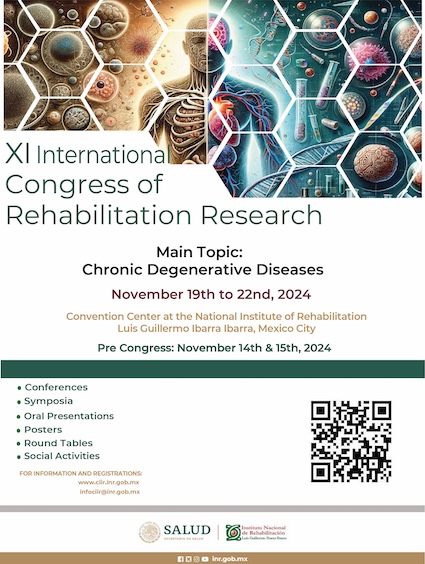Sleep Disorders as Disabling Alterations in the General Population
Keywords:
sleep disorders, disability, rehabilitationAbstract
Sleep disorders are alterations that in secondary way results in limitation of the daily development of the physical and cognitive activities, and thus are considered as disabling alterations. In the present review we analyze the classification of sleep disorders and the functional alteration that each sleep disorder produce. At last, several strategies for attention in rehabilitation of sleep disorder are proposed.
References
World Health Organization. How to use the ICF. A practical manual for using the International Classification of Functioning, Disability and Health. 2013, Geneva, WHO.
Stucki A, Cieza A, Michel F, Stucki G, Bentley A, Culebras A, et al. Developing ICF core sets for persons with sleep disorders based on the International Classification of Functioning, Disability and Health. Sleep Med 2008; 9 (2): 191-8.
Gradinger F, Cieza A, Stucki A, Michel F, Bentley A, Oksenberg A, et al. Part 1. International Classification of Functioning, Disability and Health (ICF) core sets for persons with sleep disorders: results of the consensus process integrating evidence from preparatory studies. Sleep Med 2011; 12 (1): 92-6.
American Academy of Sleep Medicine. International Classification of Sleep Disorders. 3rd Ed. AASM, Darien, IL. 2013.
Rana M, Riffo-Allende C, Mesa-Latorre T, Rosso-Astorga K, Torres AR. Sueño en niños: fisiología y actualización de la revisión de la literatura. Medicina (Buenos Aires). 2019; 79 suppl 3: 25-8.
Baranwal N, Yu PK, Siegel NS. Sleep physiology, pathophysiology, and sleep hygiene. Prog Cardiovasc Dis 2023; 77: 59-69.
Prerau MJ, Brown RE, Biancho MT, Ellenbogen JM, Purdon PL. Sleep neurophysiological dynamics through the lens of multipaper spectral analysis. Physiology (Bethesda) 2017;32:6092.
Hericé C, Patel AA, Sakata S. Circuit mechanisms and computational models of REM sleep. Neurosci Res 2019;140:77-92.
Ahman SB, Ali A, Bilal M, Rashid SD, Wani AB, Bhat RR, et al. Melatonin and health: insights of melatonin action, biological functions, and associated disorders. Cell Mol Neurobiol 2023;43:2437-58.
Morin CH, Jarrin DC. Epidemiology of insomnia: prevalence, course, risk factors,amd public health burde. Sleep Med Clin 2022; 17 (2): 173-91.
Muto V, Shaffil-le Bourdiec A, Matarazzo L, Foret A, Mascetti L, Jaspar M, et al. Influence of acute sleep loss on the neural correlates of alerting, orientating and executive attention components. J Sleep Res 2012; 21 (6): 648-58.
Daley M, Morin CM, LeBlanc M, Gregoire JP, Savard J, Baillatgeon L. Insomnia and its relationship to health-care utilization, work absenteeism, productivity and accidents. Sleep Med 2009; 10 (4): 427-38.
Alqudah M, Balousha SAM, Al-Shboul O, Al-Dwairi A, Alfaqih MA, Alzouni KH. Insomnia among medical and paramedical students in Jordan: impact on academic performance. Biomed Res Int 2019; 2019: 7136906.
Young T, Paita M, Dempsey J, Skatrud J, Weber S, Badr S. The ocurrence of sleep-disordered breathing among middle-aged adults. N Engl J Med 1993; 328 (17): 1230-5.
Walia HK. Beyond heart health: consequences of obstructive sleep apnea. Cleve Clin J Med 2019; 86 (9 suppl 1): 19-25.
Lima-Silva FS, da Silva-Becerra JP, Carneiro-Mota B, Silva-de Oliveira AC, Alves Sobreira-Neto MA, Sulyvan-de Castro S, et al. Are the International Classification of Functioning, Disability and Health (ICF) domains considered in the obstructive sleep apnea instruments? An integrative review. Sleep Breath 2021; 25 (2): 1089-1100.
Doherty L, Crowe C, Sweeney B. National narcolepsy survey. Ir Med J 2010; 103 (4): 110, 112-3.
Postiglione E, Antelmi E, Pizza F, Lecendreux M, Dauvilliers Y, Plazzi G. The clinical spectrum of childhood narcolepsy. Sleep Med Rev 2018; 38: 70-85.
Siverstein B, Harvey AG, Gradlsar M, Pallesen S, Hysing M. Delayed sleep phase disorder in young adults: prevalence and correlates from a national survey of Norwegian university students. Sleep Med 2021; 77: 184-191.
Nesbitt AD, Dijk D-J. Out of synch with society: an update on delayed sleep phase disorder. Curr Opin Pulm Med 2014; 20 (6): 581-7.
Vanttola P, Puttonen S, Karhula K, Oksanen T, Härma M. Prevalence of shift work disorder among hospital personnel: a cross-sectional study using objective working hour data. J Sleep Res 2020; 29 (3). e12906.
Oluwole OSA. Lifetime prevalence and incidence of parasomnias in a population of young adult Nigerians. J Neurol 2010; 257 (7): 1141-7.
Ariza-Serrano J, Santana-Vargas D, Millan-Rosas G, Santana-Miranda R, Rosenthal L, Poblano A. Parasomnias related to shift work disorder among medical residents during the first year of training in Mexico. Sleep Biol Rhythms 2023; 21 (1): 105-111.
Davaadorj A, Byambajav P, Munkhsukh M-U, Och M, Zorigt S, Boldbaatar D, et al. Prevalence of restless leg syndrome in Mongolian adults: Mon-timeLine study. J Integr Neurosci 2021; 20 (2): 405-9.
Hornyak M, Feige B, Riemann D, Voderholzer U. Periodic leg movements in sleep and periodic limb movements disorder: prevalence, clinical significance and treatment. Sleep Med Rev 2006; 10 (3): 169-77.
Firman M, Reyes M, Becerra N, Flores G, Weitzman M, Espinoza P. Bruxismo del sueño en niños y adolescentes. Rev Chil Pediatr 2015; 86 (5): 373-9.
Published
How to Cite
Issue
Section
License
Copyright (c) 2024 Instituto Nacional de Rehabilitación Luis Guillermo Ibarra Ibarra

This work is licensed under a Creative Commons Attribution 4.0 International License.
© Instituto Nacional de Rehabilitación Luis Guillermo Ibarra Ibarra under a Creative Commons Attribution 4.0 International (CC BY 4.0) license which allows to reproduce and modify the content if appropiate recognition to the original source is given.




